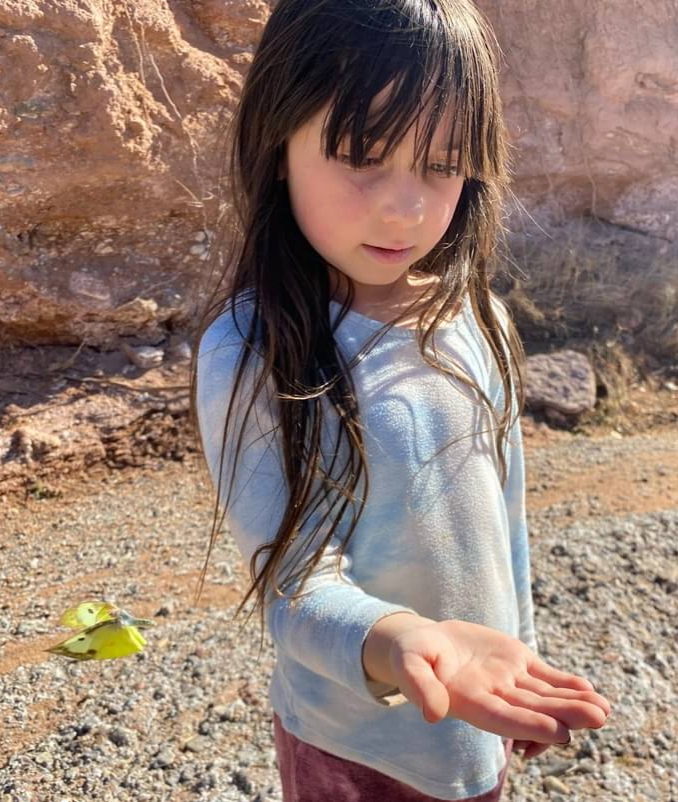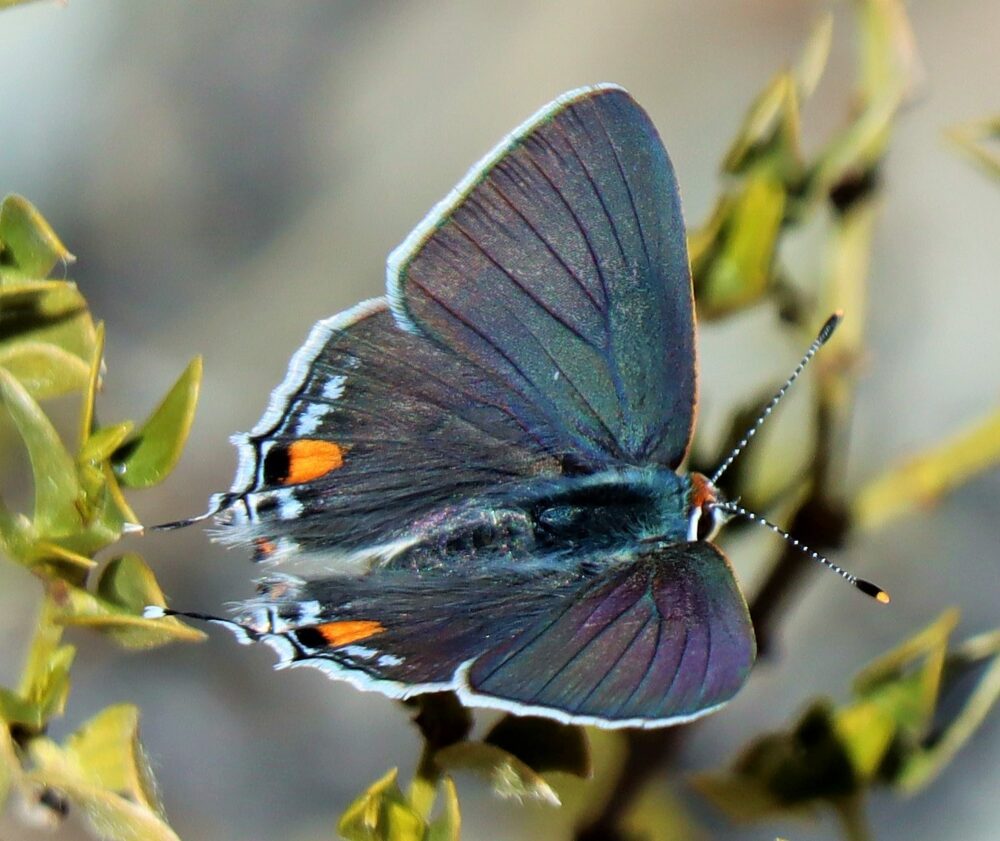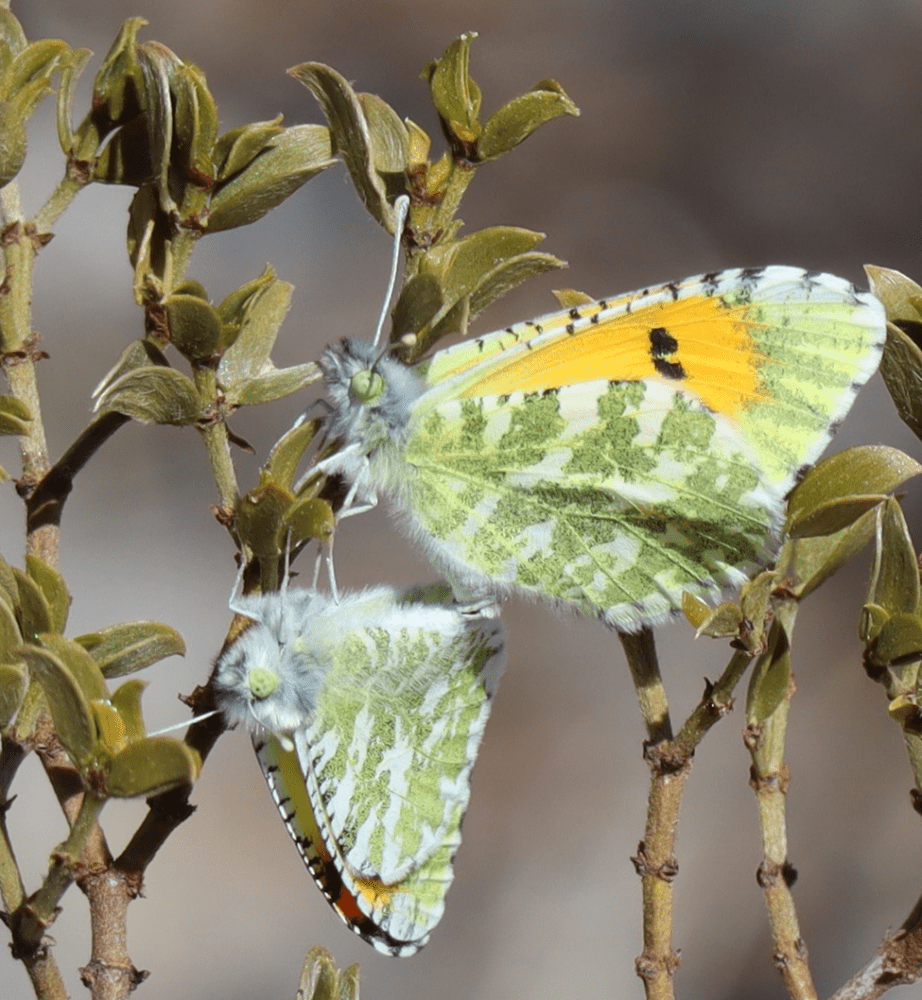© Steven J. Cary, March 31, 2022
A year ago (March 2021) I blogged about the wonders of the spring butterfly season in New Mexico. In “Butterfly Rites of Spring I” I detailed the various butterfly species which overwinter as adults and then are the first butterflies to decorate spring, especially in our mountain areas. A couple of weeks later In “Butterfly Rites of Spring II” I focused on our southern areas where males and females of several species actively seek mates on desert hilltops. Now here it is, a year later, late March 2022, and Planet Earth again finds itself in that arc of its orbit where northern hemisphere days are lengthening and temperatures are warming. It is SPRING!! and with it come those very same New Mexico butterfly phenomena.
Many of you are seeing and photographing hibernating commas (Question Mark, Hoary Comma, Satyr Comma) and tortoiseshells (Mourning Cloak, California Tortoiseshell and Milbert’s Tortoiseshell) and reporting your results to BAMONA and iNaturalist. I have not seen any of those guys yet (Santa Fe has not yet had a day over 61 degrees!), so I am appreciating them through you.
As for that desert hilltopper phenomenon, it is the subject of our feature story, Festive at the Top, which comes to us thanks to Jim Von Loh. It follows some briefs notes and acknowledgements.

First, from Hira Walker: On Saturday, March 5, we traveled down to the Quebradas (Socorro County) to visit a spring where we have had good numbers of butterflies in the past. Our hope was to have Brooke catch her first butterfly of the year, and she did. It was a male Southern Dogface. Just downstream, we spotted the female. We saw a Mourning Cloak as well, but that was it. Been seeing a few Mourning Cloaks lately elsewhere. When I got home and uploaded the photos to Facebook, a friend remarked on the timely symbolism in the photo of Brooke releasing the butterfly, with the blue color of her shirt and the yellow of the butterfly and her setting it free.
Secondly, I blogged recently about my perception that more and more of you are out there observing and photographing butterflies and then submitting your images to BAMONA for identification or for citizen science. After making that bold statement, I thought I’d better check my facts. Are BAMONA submittals truly increasing? In February, I reached out to Kelly at BAMONA to ask if that kind of data was available for review. She promptly shared a MSExcel spreadsheet containing all approved New Mexico submittals, totaling more than 8,000, pre-sorted by approval date. Discounting about 4,000 historical records uploaded at BAMONA’s kick-off in 2004, I tallied the subsequent annual totals and then charted the results as shown below.

As you can see, the number of approved NM butterfly submittals to BAMONA increased by a factor of about 5 between 2019 and 2020. Maybe that is a COVID bump? Or a citizen science bump? Whatever it is, kudos to each of you for doing your part to build the global butterfly photo database! And thank you, Kelly, for letting us see the data for ourselves. I can hardly wait to see how we do in 2022!
Third, here is my first New Mexico butterfly of the year, which I found while rummaging through my very diminished pile of firewood. . . . any guesses as to its identity?

Next is our feature presentation, Festive at the Top, by Jim Von Loh, for which I offer a brief preface: In the observation notes for his recent BAMONA submittal 1321031, Jim got my attention with the following: “On March 17, several desert orangetips were perching and sunning on creosote bush shrubs while defending territory from each other and desert marbles. A pair of them conducted courtship and mating while being “attended” by 1-to-5 other individuals. They separated after ~20 minutes of being paired.” Then followed six of Jim’s beautiful photographs illustrating the scene. In approving his BAMONA submittal, I gushed over the photos. I had never witnessed, let alone photographed, a mated pair of Desert Orangetips, so I reached out for more. With Jim, there is almost always more. Over the next couple of days he laid out the whole story . . .
Festive at the Top, by Jim Von Loh
This adventure in hilltopping desert butterflies took place a few miles north of Las Cruces within the Chihuahuan Desert Nature Park, on the 5000-ft elevation crown of Observation Hill, an east-facing arm of the Doña Ana Mountains. The afternoon was under full sun, cool, with wind gusts whipping the hilltop.

On the first afternoon, the straight-line wind direction was NW-to-SE and I would estimate it around 35-40 mph. I can’t sneak up on butterflies while walking on crunchy rocks and vegetation, so I had to find a site that was sufficiently protected from the wind that they would use it, and where I could set up my “studio.” I noticed that the wind would elevate/lift as it reached the hill crown, leaving a band of relatively calm air downwind along the southeast shoulder of the summit, and that’s where butterflies were most active.
In that warm, calm air, several species of butterflies were active, including Desert Marbles (Euchloe lotta), Desert Orangetips (Anthocharis cethura) and Gray Hairstreaks (Strymon melinus), all well-known for their hilltopping proclivities. I was paying particular attention to the Gray Hairstreaks and getting photographs when a pair of flashing yellow wings caught my attention off to one side. The yellow butterfly repeatedly flashed its wings open and then closed them – several times at short intervals.


Upon closer investigation, the one butterfly became two Desert Orangetips that were seriously courting and then mated. About the same moment I realized what was happening, I realized that other orangetips had noticed, too. Other males were trying to get her attention by any means possible. The action became pretty crazy and it actually took me a while to set up some photographs. I snapped many images during the period of time the pair was present.









March 19: I returned to the site today because I knew that two or three Chihuahuan Pineapple Cactus (Echinomastus intertextus) would be flowering (they had swelled buds two days ago) and I wanted to see if any of these butterflies would visit the flowers and possibly be considered as pollinators . . .

I found three Chihuahuan Pineapple Cactus (CPC) flowering on the crown of Observation Hill, with eight flowers open. Note that these were the only available flowers on this dry, windy hilltop. A few Desert Marbles nectared from them while many Desert Orangetips visited CPC flowers frequently. In previous years, predominantly bees, beeflies, flies, and other assorted insects would visit these flowers; today’s are the only butterflies I’ve ever seen visit CPC flowers. Orangetips would land on a flower and nectar for a brief period of time – usually less than 10 seconds each trip. They were easily intimidated off the flowers by more aggressive bees, especially honey bees. Below are a few examples of CPC flower visits by butterflies and bees between noon and 2pm.

Wind velocity was light (10-15 mph) and CPC grows in rocky substrate on the hill crown and slightly down-slope to the N/NE. This is an open site with some herbaceous and little shrub cover. I watched as butterflies approached the two primary CPC flower clusters from the S/SE. I positioned myself within 4-6 feet of each plant and facing the approaching butterflies.

Hilltopping butterflies seem always to be on full alert and easily alarmed by clumsy human intruders. I move slowly, make as little noise as possible. I try not to make quick movements, stop frequently, and remove my “predator eyes” (sunglasses) when I am within the habitat. One perceived advantage on entering this site may be that a few grazing cattle are present during this season and they do access the hilltop a little, searching for forage, and coincidentally, I was wearing a black top-shirt.

I try to be cognizant of the sun angle when approaching/selecting a site for photos, preferring it to be at my back or quartering but adjusting for side glare or even shooting into the sun for back-lighting if I need to orient in that manner. When stationary (letting the critters fly to me rather than pursuing) I try to move little, keep the shiny lens pointed down, and twist to shoot rather than taking an adjustment step, which causes sudden movement and noise. I suspect that the retained memory of a butterfly is short, so I just try to be a non-threatening part of its landscape.

I have to “cop” to a little ruse I used on our tiny, fluttering friends on day one, March 17. When I was scanning the hilltop for a place with high probability of photographic success, I took a recon stroll, crunching along the upper southern hillslope to determine what they were doing (hiding, perching, sunning, etc.) along with the habitat structure and wind velocity. First, I disturbed a hiding Desert Marble that flew up, circled, and immediately landed on the top of my water bottle carried in my cargo pant-leg pocket; it is bright, shiny white. A little further, another Desert Marble did the same thing, as did a pair of Desert Orangetips. So, when I selected my hillslope studio, I wetted the top of the water bottle and sat it among sun-warmed rocks near the creosotebushes I was monitoring. Within minutes a Desert Marble checked it out as did Orangetips. It became my inspiration for returning to check on the CPC flowers/visitors as they, too, are bright, shiny white.

In closing, and consistent with my tendency to anthropomorphize and muse . . . this foregoing photo-documentation could have been accomplished only under the influence of the Full Worm Moon:

Thanks so much, Jim, for that inspired story. And thank you for permission to use some of your images in Butterflies of New Mexico!
March 2022 is coming through with some precipitation almost statewide. That bodes well for butterflies and their admirers. As Hira Walker recently suggested, channeling her Maurice Sendak . . . Let the Wild (Butterfly) Rumpus Begin!

What an absolutely wonderful post. Besides the most excellent photos, I appreciated the discussion of how they were taking. Very inspiring.
Hi and THANK YOU! Steve – you performed an amazing editorial organization that flowed perfectly throughout. What a way to smooth all the rough edges I provided since I was still collecting and processing images and information when you first contacted me. It’s always my priority to provide images and information that provides educational opportunities and perhaps increases scientific knowledge, so again, thanks for your expertise, the insight you readily provide to us, and for finding a “home” for my and other’s observations!!
What a delight to see all the gorgeous pictures of Desert Orange tip in sequence thanks to Jim Von Loh.
Also Desert Marble pictures too!
Great post–these are really fun and informative. I always learn something from these posts. And Jim–wow, what great pictures! I’ve never seen a desert orange-tip, and you got some beautiful photos! We’re headed to El Paso next weekend and maybe we’ll be lucky enough to see one if they’re still flying.
Ralph, thanks for your kind comments. Their peak flight has probably passed, but you still have a decent chance at them. Hilltops in the Franklin Mtns. should be OK. You also might try for Dury’s Metalmark (Apodemia duryi) in adjacent lowlands. that species seems to be peaking about now, especially around the perimeter of Tortugas Moountain (“A” Mtn) southeast of Las Cruces.
These observations and images are truly amazing! I have spent a lot of time in the field observing desert orangetips and marbles (50 years) and have never seen nor heard of this kind of adult behavior! Wow! Cactus flowers? Are you kidding me? Splendid! Splendid!
Jim, I love that comment. I invite Jim Von Loh to weigh in, but I suspect it was the only nectar game in town during this drought. Hippocrates might say . . . desperate times call for desperate measures. Sure makes for terrific images!
Steve- I have sometimes been on the cusp of capturing a great photo of a butterfly when an aggressive bee interposes and ruins the moment. Is there any strategy for this? Do something to persuade the bee to go away? Same problem with hummers.